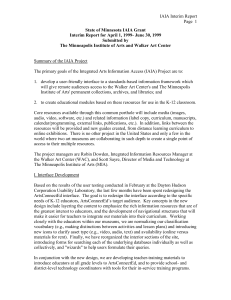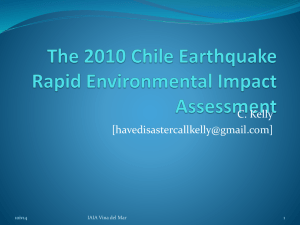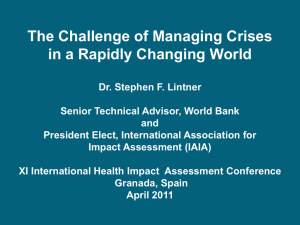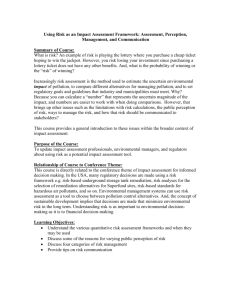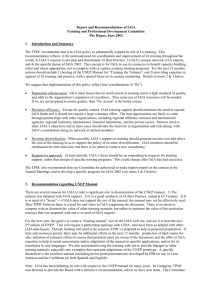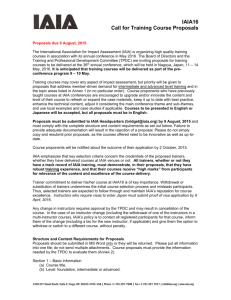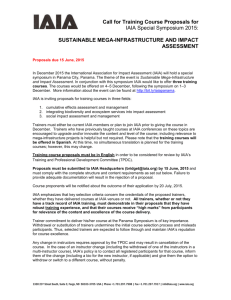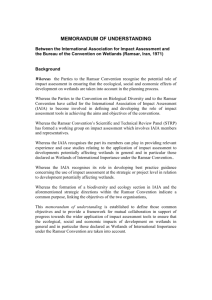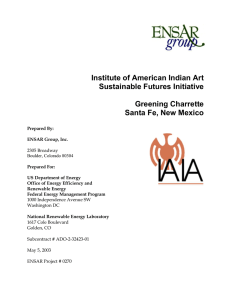Word - Walker Art Center
advertisement
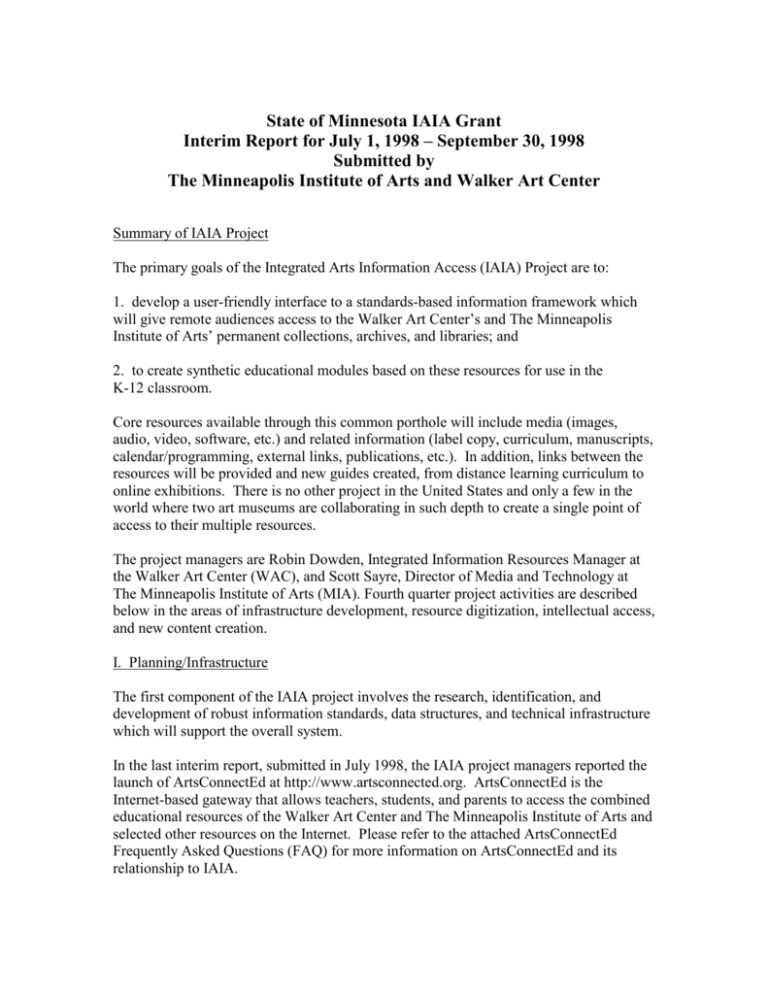
State of Minnesota IAIA Grant Interim Report for July 1, 1998 – September 30, 1998 Submitted by The Minneapolis Institute of Arts and Walker Art Center Summary of IAIA Project The primary goals of the Integrated Arts Information Access (IAIA) Project are to: 1. develop a user-friendly interface to a standards-based information framework which will give remote audiences access to the Walker Art Center’s and The Minneapolis Institute of Arts’ permanent collections, archives, and libraries; and 2. to create synthetic educational modules based on these resources for use in the K-12 classroom. Core resources available through this common porthole will include media (images, audio, video, software, etc.) and related information (label copy, curriculum, manuscripts, calendar/programming, external links, publications, etc.). In addition, links between the resources will be provided and new guides created, from distance learning curriculum to online exhibitions. There is no other project in the United States and only a few in the world where two art museums are collaborating in such depth to create a single point of access to their multiple resources. The project managers are Robin Dowden, Integrated Information Resources Manager at the Walker Art Center (WAC), and Scott Sayre, Director of Media and Technology at The Minneapolis Institute of Arts (MIA). Fourth quarter project activities are described below in the areas of infrastructure development, resource digitization, intellectual access, and new content creation. I. Planning/Infrastructure The first component of the IAIA project involves the research, identification, and development of robust information standards, data structures, and technical infrastructure which will support the overall system. In the last interim report, submitted in July 1998, the IAIA project managers reported the launch of ArtsConnectEd at http://www.artsconnected.org. ArtsConnectEd is the Internet-based gateway that allows teachers, students, and parents to access the combined educational resources of the Walker Art Center and The Minneapolis Institute of Arts and selected other resources on the Internet. Please refer to the attached ArtsConnectEd Frequently Asked Questions (FAQ) for more information on ArtsConnectEd and its relationship to IAIA. IAIA Interim Report page 2 Fine-tuning the Inquery search engine and developing the Web pages that access the MIA and Walker resources was a dominant body of work during the project's fourth quarter. As previously reported, Inquery is an innovative, flexible search engine that is being used by several other large Internet resource projects such as the Library of Congress American Memory Project and the United States Holocaust Memorial Museum Learning Center. Its particular strengths include the ability to handle free text as well as database records, so that the user can search across all of an institution's information resources without the institution having to mark it all up in advance. Template pages to display query responses were completed for each type of information resource, i.e., artworks and related images, audio and video assets, education materials, library records, texts, and Web documents. Our initial page designs and query strategies were reviewed and changed as a result of user testing conducted in the Dayton Hudson Corporation (DHC) Usability Laboratory (a detailed description of the DHC evaluation is included below under section IV). On September 1, Jim Blackaby, previously the Senior Systems Developer for the United States Holocaust Memorial Museum, was hired as the IAIA System Analyst. Over the next year, Blackaby will be responsible for further development of the project's Inquery databases and search functionality. A noted authority on cultural heritage information resource management, Blackaby's move to Minneapolis is viewed as a significant addition to an already impressive project team. In September, the MIA and Walker IAIA project teams began defining the next cycle of product and process objectives, constraints, and alternatives. Project goals for year two include: refining and documenting content conversion procedures, i.e., developing scaleable procedures for moving MIA and Walker collections information from local management applications to publicly-accessible Internet resources; resource promotion and evaluation with user communities, notably K-12 educators and students; resource expansion (see attached matrix of resource conversion goals); and interface development, including the refinement of information access methods and movement toward accommodating disabled Web users. II. Digitization The second component of the IAIA project involves the digital conversion of assets from both institution’s collections, archives, libraries, and programming. To date, over 1,000 images of artworks from the collections of the MIA and Walker are available through ArtsConnectEd. Each object image is available in four sizes: small (72 x 72 pixels) and large (160 x 120) thumbnails, quarter-screen images (320 x 240), and zoomable details of images up to 16x magnification. For a complete inventory of currently available assets and digitization goals to be achieved by June 30, 1999, see the attached matrix of IAIA Online Resources. IAIA Interim Report page 3 III. Intellectual Access The third component of the IAIA project is the “markup” of the digitized assets so that they can be easily found and used according to multiple criteria. During this period, both the MIA and Walker stepped-up their participation in national and international initiatives engaged with networking cultural resources. On behalf of the IAIA project, Robin Dowden attended meetings of the Consortium for the Computer Interchange of Museum Information (CIMI) Dublin Core Metadata Working Testbed Project in Halifax, Nova Scotia (June 1998) and Santa Monica, California (September 1998). Dowden contributed over 8,000 Walker collection records in Dublin Core (DC) format to the testbed repository. This project is evaluating the feasibility of DC for the museum community by examining assumptions related to generating records; provides a forum for understanding and resolving issues concerning the operational aspects, technical infrastructure, intellectual challenges, and economics of DC record creation; and promotes international consensus on DC practices in the museum and cultural heritage community. In August, Walker Art Center Archivist, Jill Vetter, attended the first membership meeting of Conceptual & Intermedia Arts Online (Project CIAO). CIAO is a collaborative project between seven institutions to create networked access to educational and scholarly material on the broad theme of conceptual art. The testing and development of standards and guidelines for implementing standards for collection access are key pieces of the CIAO project. Two primary technical standards will be used in the CIAO project; XML and EAD. XML, Extensible Markup Language, is an international standard approved by the W3C, and ensures that conforming documents will be readable/interoperable across diverse computer platforms and networks such as the Internet. This also makes them relatively long-lived in today's dynamic electronic environment. The EAD, Encoded Archival Description, is a specific implementation of XML -- a set of elements (tags) for describing cultural/archival collections. EAD is also an international standard, maintained by the Library of Congress and the Society of American Archivists. While XML provides a durable, portable format for our collections information, the EAD provides an accepted structure enabling complex searching and direct interoperability with the larger information universe such as university, library, and archive databases. The standards being adopted by CIAO are of interest to IAIA for the following reasons. As museums begin to provide general public access to collections information, they are finding that the item-level records contained in their collections databases are enough for internal management, but that more context is needed for meaningful access and learning purposes. Conceptual art in particular requires this additional context and relation to be accessed meaningfully. The EAD allows museums to create collection-level records that can contain fuller narrative descriptions such as interpretive or scholarly texts. These collection-level records can then include groups of objects or documents organized hierarchically to convey historical or other relationships, and these groups can contain detailed item-level records, usually taken from the collection management database. Several recent museum community projects have cited the need for a collection-level IAIA Interim Report page 4 record standard for museums, as the whole sometimes lends meaning to any one object, or it may be the only feasible level at which detailed subject cataloging is feasible. Many museum Web sites provide item-level records in detailed databases, but collection-level records as static unrelated text documents. CIAO will test the use of EAD as a way to integrate these resources. In September, MIA and Walker staff attended the membership meeting of the Art Museum Image Consortium (AMICO). This group -- now comprising twenty-five art collecting institutions in North America -- has assembled a digital library of about 20,000 works for educational use. The beta AMICO library is now being used in a University Testbed Project, by eighteen campuses, and made available through the Research Library Group. Testbed projects are addressing a research agenda that identified questions around the definition of critical mass and integration of digital resources into art and humanities teaching. A thumbnail catalogue and other background about AMICO can be found at http://www.amico.net. IV. Creating New Content The fourth component of the IAIA project requires the development of original, “added value,” educational, and exhibition-related content. This quarter, both institutions have added new mechanisms for accessing the educational materials available through ArtsConnectEd. The MIA and Walker have indexed their educational resources, including online activities, slide sets and curriculum materials. Teachers and parents can now easily access available curricula by grade level, Minnesota Graduation Standards, institution, and those having online activities. The indexes have been integrated into the Inquery database, which means that every time a user requests the information, a new list is generated. This approach will keep the indexes up-to-date as new materials are added. Other educational features include the nearly completed first module of the Walker's unique audience-driven tour Through Your Eyes and MIA's World Ceramics, an online curriculum set. While both of these features are still in development, some fine-tuning will make these offerings innovative ways to learn about the museums' collections and programs. In addition, MIA made the catalogue Teaching the Arts available as part of the IAIA database. Within ArtsConnectEd, teachers are able to search the entire catalog, which includes slide sets, films and tours, and obtain ordering information. The technology and programs that would allow teachers to order materials and schedule tours online is being investigated. IAIA team member Paulette Jones demonstrated the World Ceramics curriculum unit and the ArtsConnectEd site to The Minneapolis Institute of Arts Teachers Advisory Group to elicit feedback and discuss strategies for conforming to the State of Minnesota’s Profile of Learning. Mary Lillesve, Manager of Systems Services Division at the Minnesota Department of Children, Families and Learning, also attended this meeting and discussed the many ways IAIA’s educational content could be integrated into the Minnesota Electronic Curriculum Repository which should come online later this fall. IAIA Interim Report page 5 In early August, the ArtsConnectEd site was the subject of a user evaluation study conducted at the Dayton Hudson Corporation (DHC) Usability Lab. The DHC lab provided a unique and sophisticated environment for user testing that included access to DHC personnel experienced in software evaluation and access to technology for observing and recording test results. Working with DHC staff, IAIA project members developed ten scenarios for user testing and identified three IAIA test groups. The testing scenarios prescribed circumstances for resource discovery ranging from a hypothetical Internet service provider's "hot pick of the day" to an Internet-based classroom assignment. In the DHC lab, each user "group" -composed of one or two individuals -- was asked to answer a series of questions using the IAIA resource. Meanwhile the IAIA project staff observed the users' interaction with and responses to the interface from behind a one-way mirror. Each session was taped and comments were logged. At the conclusion of the interviews, we reviewed user questions and compiled a list of findings and solutions. While the DHC testing was invaluable in the development of the current user interface, evaluation of the site has only begun. In year two of the project, we plan to evaluate the site in the areas of Americans with Disabilities Act (ADA) site compliance, usability, and content analysis. In September, IAIA project members went to Santa Monica to attend the Annual Meeting of the Museum Computer Network. This theme of this year's conference -- Knowledge Creation, Sharing and Preservation -- was particularly relevant to IAIA project goals and included several sessions on museum educational resources for K-12 schools and Internet-based integrated information access projects. In a session entitled "MuseumTeacher Collaborations Using the Web and CD-ROMs" Scott Sayre discussed ways in which The Minneapolis Institute of Arts and the Walker Art Center are strategically using the Internet to connect with teachers and students throughout the state of Minnesota. As a part of the presentation, Scott demonstrated educational applications of IAIA database as well as a number of online activities and curriculum units that were developed through the IAIA project. The presentation also touched on the wide variety of publicity and marketing strategies that both institutions will be using to market these extensive new resources.
